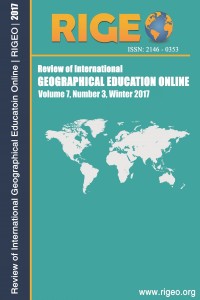Öz
Joseph Kerski, one of ESRI’s education managers, has recently authored a book that is
very obviously based on his personal enthusiasm as a geographer, who is tremendously
proud of his profession. The book’s title, Interpreting Our World – 100 Discoveries That
Revolutionized Geography, addresses the idea that a broad range of different events at
different times pushed forward the subject of geography – by geographers (in the broader
sense), who interpreted these events and made meaning of them using and developing
methods of geography. Therefore, the book mainly tells the coherent narration of how
geographers have helped to improve the world. More or less, a story of success of
geography is told, a song of praise for the geographers’ profession and abilities that bring
benefits to everyday life.
Anahtar Kelimeler
Kaynakça
- Blaikie, P.M. (1995). Changing environments or changing views? A political ecology for developing countries. Geography 80(3), 203-214.
- Hägerstrand, T. (1970). How about people in regional science? Papers of the Regional Science Association 24, 7-21.
- MacEachren, A.M. (1995): How Maps Work. Representation, Visualization, and Design. New York: Guilford Press.
- Massey, D. (1998). Power geometries and the politics of space-time. Heidelberg: Department of Geography.
- Melber, H. (2001). Der Weissheit letzter Schluss: Rassismus und kolonialer Blick. Frankfurt: Brandes & Apsel.
- NRC (National Research Council) (2006). Learning to think spatially. GIS as a support system in the K–12 curriculum. Washington, DC: The National Academies Press.
- Paasi, A. (1986). The institutionalization of regions. A theoretical framework for understanding the emergence of regions and the constitution of regional identity. Fennia 1986(1), 105-146.
- Pickles, J. (ed.) (1995). Ground Truth: The social implications of Geographic Information Systems. New York: Guilford Press.
- Schlögel, K. (2006). Im Raume lesen wir die Zeit. Über Zivilisationsgeschichte und Geopolitik. München: Fischer.
- Wardenga, U. (2002). Räume der Geographie. Zu Raumbegriffen im Geographieunterricht. Geographie heute 200(23), 8-10.
- Werlen, B. (1993). Society, action, and space. An alternative human geography. London: Routledge.
Öz
Kaynakça
- Blaikie, P.M. (1995). Changing environments or changing views? A political ecology for developing countries. Geography 80(3), 203-214.
- Hägerstrand, T. (1970). How about people in regional science? Papers of the Regional Science Association 24, 7-21.
- MacEachren, A.M. (1995): How Maps Work. Representation, Visualization, and Design. New York: Guilford Press.
- Massey, D. (1998). Power geometries and the politics of space-time. Heidelberg: Department of Geography.
- Melber, H. (2001). Der Weissheit letzter Schluss: Rassismus und kolonialer Blick. Frankfurt: Brandes & Apsel.
- NRC (National Research Council) (2006). Learning to think spatially. GIS as a support system in the K–12 curriculum. Washington, DC: The National Academies Press.
- Paasi, A. (1986). The institutionalization of regions. A theoretical framework for understanding the emergence of regions and the constitution of regional identity. Fennia 1986(1), 105-146.
- Pickles, J. (ed.) (1995). Ground Truth: The social implications of Geographic Information Systems. New York: Guilford Press.
- Schlögel, K. (2006). Im Raume lesen wir die Zeit. Über Zivilisationsgeschichte und Geopolitik. München: Fischer.
- Wardenga, U. (2002). Räume der Geographie. Zu Raumbegriffen im Geographieunterricht. Geographie heute 200(23), 8-10.
- Werlen, B. (1993). Society, action, and space. An alternative human geography. London: Routledge.
Ayrıntılar
| Birincil Dil | İngilizce |
|---|---|
| Bölüm | Book Review |
| Yazarlar | |
| Yayımlanma Tarihi | 31 Aralık 2017 |
| Gönderilme Tarihi | 18 Ekim 2017 |
| Kabul Tarihi | 12 Aralık 2017 |
| Yayımlandığı Sayı | Yıl 2017 Cilt: 7 Sayı: 3 |


